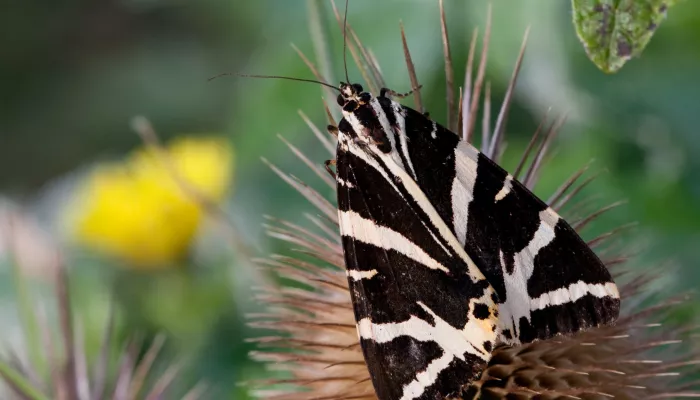Margery Thomas, Hothfield Volunteer and regular columnist looks at the lack of butterfly sightings in recent months, the work volunteers are doing to remove bracken and how this all impact the wider management of the last remaining fragments of heathland we have left in Kent.
Writing in mid-July, butterfly sightings were thin. Rain brought a small welcome increase, including a Jersey tiger moth Euplagia quadripunctaria. This name is from the Greek eu = beautiful, plagia = oblique, describing the cream markings on the black forewings; Latin quadri = four, punctaria from spot, referring to the black points on the red under-wings. Thanks to volunteer David Rayner for finding that in the Monaco Nature Encyclopaedia.
The moth has this century spread inland into southern England including London and as far as Norfolk. It is cathemeral, ie flies in the day- and night-time, from July to September. Pearly eggs are laid in late summer on nettles, brambles and hemp agrimony and the hairy caterpillars overwinter, munching and moulting before pupating in spring among leaf litter. Food plants include nettle, hemp-agrimony, white dead-nettle, borage, plantains, ground-ivy and brambles, many of which can be left in wilder patches of gardens, along with the leaf litter and slightly longer grass. To quote from Bugwoman’s blog, “All sorts of creatures are living amongst and inside those tatty plants.”
The 2024 Big Butterfly Count will help trace the spread of the Jersey tiger moth. Sadly, we know it’s been a bad year for butterflies and moths. We won’t match Gilbert White’s diary entry of 10 August 1768 in Selbourne: “White butter flies (sic) gather in flocks on the mud of the puddles.” Even the common ragwort hasn’t attracted the usual numbers of insects. David Rayner writes: “it is one of our most valuable mid-summer native flowering plants. Apart from being the larval food plant of the beautiful Cinnabar moth, it provides copious quantities of nectar and pollen for a wide range of insects - bumblebees, solitary bees, hoverflies, beetles, true bugs, butterflies, shield bugs and more.”
The volunteers have been scything bracken in the heathy areas, revealing ever more heather. Hazel and Beech, the Iron Age pigs, are back and can be seen from the concrete causeway. Ian Rickards reports: “they move between a number of Kent Wildlife Trust nature reserves, living a wonderful free-range life. Wild boar would have been an important eco-engineer across the UK, and these pigs will replicate a lot of their behaviour. They will rootle in the soil, digging for roots and invertebrates. Much like digging a garden over, this behaviour encourages new fresh growth, reduces dominance of certain plant species, including the irrepressible bracken. We hope visitors will enjoy them, but as with all our livestock. please don’t feed them.”
In July the Flow Country, some 200,00 hectares of peatland in Caithness and Sutherland, became a UNESCO World Heritage Site, as the most outstanding example of an actively accumulating blanket bog landscape. It is the first peatland World Heritage Site. It is Scotland’s first World Heritage Site inscribed purely for natural criteria, and only the sixth natural site in the UK. The significance of the peatlands as important carbon sinks and specialised biodiverse habitats, and of the “stewardship of the farmers and crofters in maintaining this incredible ecosystem as a natural legacy for future generations” is reflected in miniature in the Hothfield SSSI. There’s just 80 hectares of heathland left in Kent, with peatland a small proportion within that. Hothfield, like the Flow Country, has bogbean, sundew, bog asphodel, an important range of sphagnum moss species, drier hummock microsites, and stewardship by Ashford Borough and local parish councils, KWT, volunteers, local residents and walkers. The contrast in size of the two areas simply emphasises the rarity and vulnerability of this habitat in Kent.
The comments by UNESCO GB about the Flow Country apply equally to Hothfield Heathlands, this important but tiny site on our doorstep.
These sites belong to everyone, and it is everyone’s duty to protect them for future generations. They are ours to share, to cherish and to respect. Their disappearance would be an irreparable loss to humanity.UNESCO

